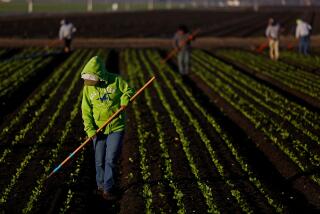Farm Policy Bill Has Growers on Both Sides of the Fence
- Share via
CARRINGTON, N.D. — After 20 years of growing wheat in North Dakota, Charles Linderman has gotten used to digging out of snowdrifts hurled in by late February gusts from Canada. These days it is a harsh wind blowing in from the southeast--Washington, to be exact--that has the normally laid-back Linderman in an uproar.
With the House prepared to follow the Senate in voting this afternoon or Friday to revamp the nation’s decades-old farm policy, Linderman fears that the phasing down of subsidies over the next seven years could hasten the decline of family farming in the Great Plains, where an exodus of discouraged farmers over the years has turned many a once-thriving rural community into all-but-abandoned outposts.
“Sometimes our entire net income was the government payment,” he said of the 1,500-acre spread on which he and his wife, Ellen, grow wheat and sunflowers. “It’s kind of scary to go without a safety net.”
His younger neighbor, Jim Harmon, sees things much differently. The “Freedom to Farm” measure, he contends, is a chance for farmers to break loose of onerous, outdated regulations and diversify away from wheat into crops that will be better for the land and perhaps more profitable on world markets. He journeyed to the U.S. capital this week to show his support.
Farmers don’t get much more dependent on government subsidies than they are here in east-central North Dakota, where wheat has been the chief crop of choice for generations and annual payments from Uncle Sam have often made the difference between subsistence and comfort.
But the fact that farmers here stand on both sides of the farm-policy fence demonstrates the fundamental changes underway in family farming as agriculture becomes more global and taxpayers increasingly decry rural “welfare” at a time of robust grain prices and federal budget cuts.
Overall, North Dakota farmers from 1990 through 1994 received more than $1.3 billion in wheat deficiency payments alone, and the state routinely ranks in the top 10 of payment recipients.
(California farmers tend to grow crops such as fruits, vegetables and nuts that do not qualify for such payments. Despite being the nation’s leading agriculture state, California receives just 2% to 4% of the subsidies at issue.)
As lawmakers in Washington heatedly debated the farm bill Wednesday, farmers hereabout braved 5-degree temperatures to shovel out from a late-season snowfall that had forced many schools and offices to close.
Among the businesses that carried on were two farmer-owned cooperatives on which many local people are pinning their hopes: a $40-million pasta-making plant in Carrington (whose trademark blue packages occasionally merit a cameo on the “Seinfeld” TV series) and, in nearby New Rockford, a bison-slaughtering plant that turns out steaks, sausage and jerky for upscale restaurants in the United States and Europe.
Sensing the public’s growing dissatisfaction with farm programs, North Dakotans years ago began looking to become more entrepreneurial. “Co-op fever” is sweeping the land as rural people band together to make and market edible and other products from their crops. With all these ventures, the operative buzzword is “value-added.”
“Rural people don’t want handouts,” said John C. Gardner, an agriculture scientist who directs North Dakota State University’s research extension center in Carrington. “They want to feel useful, purposeful. I think [under ‘Freedom to Farm’] a tremendous number of innovations would occur.”
Linderman, 51, has managed to survive some tough times in the last 20 years, in part because of the subsidies. Over the last seven years, “deficiency payments” from the government to compensate for low market prices of wheat and barley accounted for just over half his net income. The same is true for many of Carrington’s other 50 farmers.
“We could have paid expenses without it, but we wouldn’t have had anything else to live on,” Linderman said.
Under the proposed legislation, which seeks the most sweeping overhaul ever of a law dating from the Depression era, such deficiency payments would be replaced with fixed but declining payments through 2002. Farmers also would theoretically be freer to plant what they wish.
Critics say both the Senate and House bills fail to close loopholes that allow big corporate entities to obtain unfairly high payments--thereby encouraging the shift to larger, more powerful agribusiness and away from family farming. Future cuts, they add, will hurt programs designed to help beginning farmers and to fund research and conservation efforts.
Most important, opponents say, the measures would eventually strip farmers of all protection from the vagaries of weather and world markets--unless Congress has a change of heart in seven years.
“When wheat prices are high as now, a program that moves from deficiency payments to fixed payments looks pretty good, but if the bottom falls out of the market, the new system won’t look good,” said Chuck Hassebrook, a policy analyst with the Center for Rural Affairs, a research organization that endorses family farming.
That rings true with Linderman, who say proponents of the bill are taking a short view. But Harmon, 37, a fourth-generation farmer who plants 2,200 acres next to Linderman’s, said many farmers are chomping at the bit to get government out of their face and to make their own planting decisions.
Harmon said he looks forward to planting less wheat and getting into a healthier crop rotation. And he foresees in non-program crops a lot of upward potential in price, accompanied by lots of volatility--a risk he is willing to shoulder.
“The more diversity of crops, the better it is for the land,” he said.
Farmers have planted wheat so long in North Dakota’s deep topsoil--and there has been so much rain in the last three years--that diseases and pests are running rampant. Gardner of North Dakota State has taken the extreme step of recommending that farmers in many northern counties not plant wheat this year to aid in the eradication of a small bug called the wheat midge. That would leave some farmers without any crops at all.
For Linderman, perhaps the biggest question of all is what will happen to his family’s three-generation legacy of farming.
One daughter has already left the land to work in computers in Arizona; a son works as a civil engineer with North Dakota State’s Upper Great Plains Transportation Institute in Fargo, and the youngest child, a high school-age daughter, has no interest in carrying on the tradition.
Although Linderman sees family farming as his preferred way of life, he can appreciate that the ups and downs and hard work would hold little appeal for the next generation.
Perhaps, he said, “it’s just as well.”
More to Read
Sign up for Essential California
The most important California stories and recommendations in your inbox every morning.
You may occasionally receive promotional content from the Los Angeles Times.











